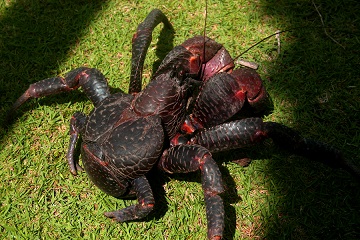Lecturers of IPB Studied Calcium Feeds as Maturation Diets for Coconut Crab

The coconut crab (Birgus latro) is a species of terrestrial hermit crab, also known as the robber crab or palm thief. It is the largest land-living arthropod in the world, and is probably at the upper size limit for terrestrial animals with exoskeletons in recent times, with a weight of up to 4.1 kg (9.0 lb). It can grow to up to 1 m (3 ft 3 in) in length from leg to leg. The coconut crab is one of the protected biota in Indonesia. To analyse the biology of this crab, three experts of Bogor Agricultural University (IPB), namely Mr. Sulistiono and Mr. Ridwan from the Faculty of Fisheries and Marine Sciences of Bogor Agricultural University (FPIK IPB), and Mr. Supyan of FPIK University Khairun, Ternate, tried to examine the life cycle and the survival of the coconut crab with artificial feeding of calcium for conservation purposes.
Study of broodstock maturation diets is important in order to increase the quality of coconut crab, which indirectly improve the larval quantity in the hatchery production of cultured species. For the purpose of the study, the broodstock coconut crabs were kept in the plastic box. The study was carried out from February to October 2016. The team took samples in several locations, including Yoi Island, Ternate, Morotai and Loleo Island (North Maluku Province). Crab maintenance is done in the Laboratory of Ecobiology and Conservation of Water Resources of FPIK IPB.
45 walnut crabs were placed on a plastic box measuring 70cm x 40cm x 40cm. One crab in each plastic box. In this study, the crabs were fed by three different feeding treatments, namely A (50% coconut, 35% flour, 5% fish meal, 2% vitamin mix, 3% mineral mix, 5% Calcium); feed B (coconut 60%, wheat 23%, fish meal 5%, vitamin mix 2%, mineral mix 3%, calcium 7%) and feed C (70% coconut, 18% flour, 5% fish meal, vitamin mix 2 %, mineral mix 3%, 2% Calcium).
Based on the laboratory work, they revealed that crabs which were fed with three different feeding treatment had various mortality rate as follows: treatment A 21%; treatment B 25%; and treatment C 43%. Whereas the survival rate were treatment A 79%; treatment B 75%; and treatment C 67%. While based on body weight observation of, the crabs treated with in A treatment gained approximately 3% body weight; treated with B treatment gained 0.5% body weight; and treated with C treatment gained 5% body weight. Finally, the researchers concluded that treatment A is the best option (with the smallest mortality rate) compared with other treatments. (Wied)



